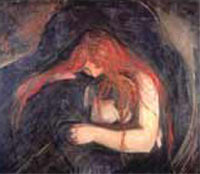Psychiatrists generally consider someone to be suffering from depression when they present at least 5 of the following symptoms almost every day for at least 2 weeks:
| SYMPTOMS, TREATMENTS, AND CAUSES OF MANIC DEPRESSION |
| Manic depression has been known since ancient times, but it was a German psychiatrist, Emil Kraepelin, who first described its symptoms more systematically, in the late 1800s. Today, specialists prefer the expression “bipolar disorder”, which avoids the negative connotations associated with the word “manic”. |  |
Unlike ordinary people whose moods are influenced by specific events in their lives, people with bipolar disorder seem to follow their own cycle of mood fluctuations. Like passengers strapped into a roller coaster, they have no choice about the ups and downs; they must simply go along for the ride.
And “ups and downs” is an appropriate description, because unlike depression (also known as “unipolar disorder”), bipolar disorder includes not only depressive states characterized by the same systems as depression, but also “manic” episodes that alternate with them.
During these manic phases, individuals are excessively exuberant. Their thoughts race feverishly, leading to extravagant behavior. They see patterns everywhere—everything seems connected to everything else, and the smallest event can take on an exaggerated meaning. These people can also be very creative; the connections that they draw between things constantly inspire them with new ideas and new theories.
More systematically, specialists often
distinguish four major categories of symptoms of
manic episodes:
1) External appearance. The individual’s external appearance is extravagant or sloppy, provocative, or even indecent. A person in a manic phase may call out to strangers in the street with an abrupt familiarity, sometimes mixed with sarcasm.
2) Mood exaltation. During manic phases, individuals feel exuberant and have extreme confidence in their own powers and charm. They have sexual adventures with no thought for the possible consequences and often with a total lack of inhibition or tact. They do not tolerate any criticism of themselves and are easily irritated and angered.
3) Accelerated thought processes. Manic individuals’ thoughts come so fast that their words can’t keep up with them. They evoke one image, then move on to the next before their listeners have had time to absorb the first one. They keep jumping from one unrelated topic to another and keep talking even if people have stopped listening. Their ability to focus their attention is greatly diminished, but their imagination is greatly amplified.
4) Motor hyperactivity. In manic phases, people don’t know the limits of their own strength. They don’t take the time to eat or sleep. They take on several projects at once without stopping to determine whether they are even feasible. These individuals make major upheavals in their lives (change jobs, go on long trips, make foolish expenditures, etc.) and may become distrustful or even paranoid, accusing the people around them of wanting want to keep them from carrying out their grandiose plans.
From all these symptoms, one can easily see why it is vital to ensure that people with bipolar disorder receive appropriate treatment quickly. Even though the causes of these diseases are still incompletely understood, there are ways to reduce their effects considerably.
1) External appearance. The individual’s external appearance is extravagant or sloppy, provocative, or even indecent. A person in a manic phase may call out to strangers in the street with an abrupt familiarity, sometimes mixed with sarcasm.
2) Mood exaltation. During manic phases, individuals feel exuberant and have extreme confidence in their own powers and charm. They have sexual adventures with no thought for the possible consequences and often with a total lack of inhibition or tact. They do not tolerate any criticism of themselves and are easily irritated and angered.
3) Accelerated thought processes. Manic individuals’ thoughts come so fast that their words can’t keep up with them. They evoke one image, then move on to the next before their listeners have had time to absorb the first one. They keep jumping from one unrelated topic to another and keep talking even if people have stopped listening. Their ability to focus their attention is greatly diminished, but their imagination is greatly amplified.
4) Motor hyperactivity. In manic phases, people don’t know the limits of their own strength. They don’t take the time to eat or sleep. They take on several projects at once without stopping to determine whether they are even feasible. These individuals make major upheavals in their lives (change jobs, go on long trips, make foolish expenditures, etc.) and may become distrustful or even paranoid, accusing the people around them of wanting want to keep them from carrying out their grandiose plans.
From all these symptoms, one can easily see why it is vital to ensure that people with bipolar disorder receive appropriate treatment quickly. Even though the causes of these diseases are still incompletely understood, there are ways to reduce their effects considerably.
So I thought this information could help us understand a bit more of how Hero was before she topped herself. Also Claudio could use some of these symptoms in the play, later on that is, when he starts to completely lose the plot.
Yup might be nice to think about hero being super manic and bouncing off the walls in the bedroom scene, which would contrast to Claudio loosing it and being anxious and her being a nut job xxx
ReplyDelete